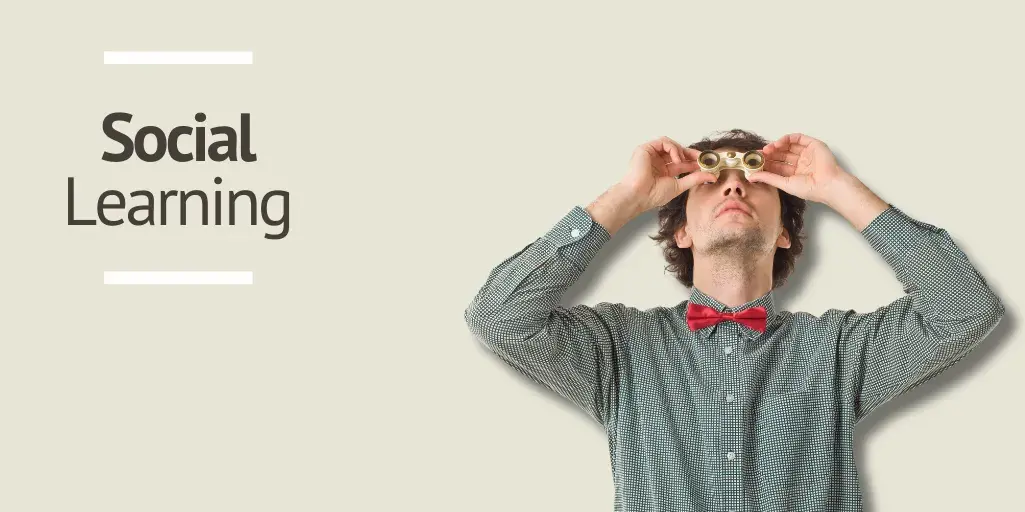What is Social Learning or Social Learning Theory?

Social Learning Theory, developed in the 1970s by Albert Bandura, has been one of the most important theories in the field of learning psychology. But what is social learning really?
Specifically, the social and emotional learning is based on including a social component to the online learning process. According to the psychologist, people learn by observing and imitating others. And this ability to be “social sponges” and absorb the experiences and knowledge of others directly influences the way we think, make decisions and act.
In the context of e-learning, learning social an approach that enables learners to learn from each other and develop essential skills to function in today’s world.
In addition, “learning from and with others” helps to mitigate the problems of isolation and demotivation that can occur when studying online. In this blog we will tell you what is the social learning meaning and in addition, we will also learn about of social learning theory in education.
Principles of Social Learning Theory
Social Learning Theory is based on four principles that influence how we learn and apply what we see:
- Attention: learning occurs when we pay attention to certain behaviours or tasks that arouse our interest. This is an aspect to take into consideration when focusing lessons and planning content or activities.
- Retention: refers to the learner's ability to internalise behaviours, and is decisive in determining whether he or she will be able to imitate them in the future.
- Reproduction: the ability to perform learned behaviours in different situations or contexts.
- Motivation: the desire to reproduce a behaviour. It may be greater if the reward or consequences of imitating it are positive.
So, we conclude that if the teaching model is novel, it should be more engaging for the students.
In turn, the more the learning social is practised, the greater the understanding and retention of knowledge should be.
Finally, if we reinforce learning in a social way, with gratification or rewards, it would also increase the likelihood that students would imitate what they learn. In this blog we will tell you what is the meaning of social learning.
How to carry out social learning?

How social learning theory works? Basically, what is needed is an e-learning platform on which we can develop social and emotional learning with all the guarantees and where we can carry out the social learning process.
To this end, it must have the tools to facilitate interaction and the exchange of knowledge and experiences in an immediate and satisfactory manner, regardless of the learner’s geographical location.
Tools and strategies to promote social learning
Through the various channels offered by the learning platform, numerous strategies can be implemented to put social learning into practice.
Discussion forums

Question and answer forums, as well as live discussion topics, allow students to verbalise their views, argue opinions and find answers with the help of their peers and teachers and is one of the main of social learning strategies.
Similarly, study groups can be organised on specific topics or real cases, in which students share resources and cooperate. Even mentoring groups can be set up for more advanced students to provide support and guidance to more inexperienced students.
In addition, forums are an ideal place to provide feedback on performance and to promote positive and constructive comments.
In general, it is a medium in which activities, such as presentations or group work, can be proposed in order to achieve common goals.
In any case, in order to make this social learning work effectively, it must be ensured that the e-learning platform allows the sharing of links, articles and other relevant audio-visual materials.
Chat for social learning

They will also need the chat to carry out all these activities. Not only to be able to express themselves in real time and argue their ideas or address problems, but also to coordinate tasks, discuss their progress and find solutions together.
In addition, the chat is useful for organising live sessions, student-teacher tutorials, and for reviewing, solving exercises or resolving doubts in an agile way before exams.
On the other hand, we can make the most of it when playing educational games, networking or other informal meetings. And, in the same way that we use internal messaging, we can use it to send announcements and reminders about deadlines, upcoming events and other important course news.
Videoconference

Today, video conferencing is a basic tool for social learning. It is the standard channel for real-time distance learning, and most systems are already equipped with tools to interact with the content and the group (virtual whiteboards, chats, etc.).
But apart from being used to deliver the lessons and bring all training participants closer together, it is also great for tutoring, answering questions and giving instant feedback.
Naturally, video conferencing offers the possibility of webinars or interviews with experts, and gives learners the opportunity to interview each other and share their experiences.
It is also advisable for presentations, debates or workshops, so that learners can confront points of view, find solutions together or simply review social learning online content.
Surveys and questionnaires

Surveys or questionnaires are valuable for obtaining feedback on students’ performance, interests and preferences, as well as their experiences in collaborating on projects.
In addition, periodic questionnaires make it possible to assess the achievement of social learning objectives and understanding of the course material, including the practical parts.
They are also suitable for self-assessment, allowing students to identify areas for improvement or for collecting data from their projects or research.
Instant messaging

Instant messaging enables fast and direct communication between all parties, which is essential for social learning and and is another of the main of social learning strategies. It is suitable for finding answers, providing learner support and, beyond that, building bonds outside the virtual classroom.
When working in teams, students can use messaging to coordinate tasks, share ideas and resources, and discuss issues with peers.
Additionally, teachers can use it to send reminders about dates, events and other information of interest to students.
Social networks

Let’s take for example a social network that we all know: Facebook.
As you know, it was not designed for social learning in education, however, its social features and multimedia tools make it a platform with great advantages for Social Learning.
On it, we can create closed groups to stimulate discussion, conduct polls, upload learning resources such as videos, presentations or images, and more.
And this is extrapolable to many social platforms. Therefore, we can encourage participation and activity in this kind of comfortable and friendly environments to improve learner interaction and engagement.
Digital resources and immersive experiences for social learning

Of course, it is possible to enrich learners’ social learning with digital resources, such as videos, podcasts or infographics, and offer immersive experiences in the virtual environment.
For example, a simple infographic, which helps to summarize important information, can show contrasting data that helps learners to better understand and delve deeper into the content. Or, in the case of a podcast, provide a broader view of a topic and pose dilemmas or different points of view that invite reflection and future sharing.
Likewise, everything that involves creating immersive virtual reality experiences, such as simulations, allows students to immerse themselves and train in a seemingly real scenario in which they can overcome challenges and make decisions as a team.
On the other hand, we understand that both a gamification strategy and game-based learning methodology stimulate students to learn with enthusiasm and make their experience memorable.
However, we must be clear that the mere fact of applying game techniques in class does not mean that we are gamifying or achieving results.
In fact, to motivate students and achieve the goals we need to introduce those proposals that can work according to the objectives of the course and the characteristics of the group. And, of course, channel them into an e-learning platform where students feel comfortable and can advance without complications or help.
Social learning examples to promote it in the virtual classroom

Here are some ideas on how to leverage Social Learning and cultivate a dynamic and efficient social learning environment in virtual classrooms. Some example of social learning are:
- Flipped classroom
- Game-Based Learning and Gamification
- Problem-based learning
- Project-based learning
- Collaborative and cooperative learning
- Peer tutoring or peer teaching
- Mentoring
- Surveys
- Discussion forums
- Webinars, roundtables and online interviews
- Virtual simulations and interactive exercises
- Social networking
- Learning communities
What are the advantages of social learning?

- It allows learners to become actively involved in the construction of their knowledge, rather than simply passively receiving content.
- Such involvement fosters deeper understanding and greater motivation to learn. Apart from the fact that the content is perceived as dynamic and easily updated.
- The use of collaborative tools facilitates the development of soft skills, such as group work, positive communication or empathy, critical skills in the work and social environment.
- This joint social learning approach and the sharing of experiences also generates a sense of belonging that drives the desire to learn and a decrease in the dropout rate.
- In the case of companies, the very closeness and synergy of collaboration makes employees stay abreast of the latest in their field and become more competitive.
The importance of social learning in Spain
In Spain, social learning is becoming increasingly important thanks to the new methodologies of online training, as well as the need to adapt to changing times.
Social learning has proven, for example, to be an effective tool in the corporate environment. A social learning theory studies shows that people who learn in social environments retain up to 70% more information compared to those who receive training in the traditional way. Specifically, in Spain, 76% of companies certified by Top Employers have integrated collaborative learning into their training strategy, which facilitates a more effective transfer of knowledge and enhances collective intelligence within organizations.
For this reason, the online training sector is committed to fostering collaboration and interaction among learners. Some of these models are project-based learning (PBL), or cooperative learning, especially in secondary education, vocational training and universities.
These types of methods also serve to improve the acquisition of knowledge and skills inherent to the training process, such as communication, critical thinking and group problem solving, aspects that are highly valued in today’s professional environment.
On the other hand, elearning platforms are also joining this trend, including functionalities that facilitate interaction between users, whether they are students, teachers or administrators. We already know these tools: chat, discussion forums or video calls, among others.
In the end, the idea is to replicate the traditional collaborative or face-to-face experience, but in a digital form. An example would be live classes via the screen, in which, of course, questions can be asked in real time or a debate can be generated among students.
If social learning is gaining ground in Spain it is, in part, due to specific initiatives in various educational institutions and technological platforms that promote this collaboration and interaction. Below are several examples that corroborate this trend:
- University of Granada and the SWAD platform. It is a learning management system that facilitates interaction between students and teachers. SWAD (Social Workspace At a Distance) allows the management of subjects and promotes effective communication in virtual environments, being a key tool in distance education and the promotion of social learning.
- The European IDEAL Project, led by the University of Burgos and the Miradas Foundation, has developed the Ideal Connect platform. This tool is designed to bridge the digital divide in people with autism, facilitating their social and educational inclusion through the adaptation of specific digital applications. Ideal Connect is an example of how technology can be used to promote social learning and inclusion.
- The Sonic Onion” methodology in vocational training. It combines tiered learning, gamification and the use of emerging technologies such as artificial intelligence and augmented reality. This innovative approach of "The Sonic Onion" has revitalized student motivation and has been recognized internationally, highlighting the importance of active methodologies in social learning.
